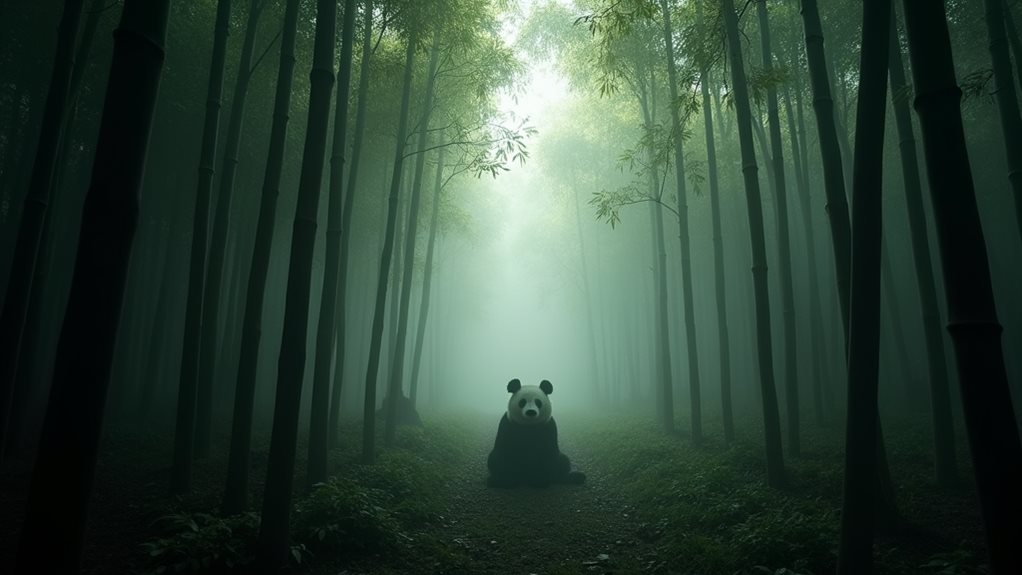
To disclose the invisible panda, trace the enigmatic bamboo leaf footprints and listen to nature's whispers, revealing hints of its presence. Deciphering Lisas's riddles enhances your understanding, while mastering panda camouflage will fine-tune your observation skills. Focus on subtle rustles and faint shadows—they're essential clues pointing toward the panda's elusive behaviors. Keep honing your senses, and you'll unearth more secrets, drawing you closer to spotting this master of concealment in its natural habitat.
Key Takeaways
- Observe bamboo leaf-shaped footprints to track the panda's movement and possible locations.
- Listen for subtle rustles in the bamboo indicating a panda's presence.
- Analyze shadows and movements in the forest to distinguish panda shapes.
- Decode Lisas's riddles to uncover hidden clues about panda behaviors and habitats.
- Heighten sensory awareness to spot minute disturbances caused by elusive pandas.
Tracing the Enigmatic Path of the Bamboo Leaf Footprints

Why do footprints shaped like bamboo leaves guide us deeper into the forest?
These bamboo leaf patterns on the forest floor aren't just intriguing; they're a sign of the mysterious trails that beckon further investigation.
You're walking where a heavy, unseen creature has recently passed, stirring the ground beneath its weight.
Each footprint holds a clue, intricately linked to the natural surroundings and the behaviors of elusive wildlife.
Analyzing these signs, you discern the direction and perhaps even the purpose of this journey.
It's a puzzle woven into the very fabric of the forest, challenging your understanding of nature's subtle cues.
Interpreting Nature's Whispers and Shadows
As you explore deeper into the bamboo forest, the whispers and shadows around you become an essential guide. The whispered secrets of rustling leaves might signal the panda's recent passage.
Careful observation of shadow play helps distinguish subtle movements from mere optical illusions.
Here's how to interpret these signs:
- Listen Intently: Decipher whispered secrets from the wind, indicating movement and presence.
- Analyze Shadows: Identify patterns in shadow play that suggest the panda's shape or movement.
- Correlate Information: Combine auditory and visual clues to pinpoint the panda's location with greater accuracy.
Your journey through nature's whispers and shadows sharpens your interpretive skills.
The Art of Decoding Lisas's Riddles and Clues

Moving beyond interpreting nature's subtle cues, you now face the challenge of solving Lisas's riddles, each ingeniously crafted to lead you closer to the elusive invisible panda.
Your success hinges on meticulous clue analysis and recognizing riddle patterns. Each riddle serves as a puzzle piece, revealing more about the hidden behaviors and habitats of the panda.
You explore the intricacies of Lisas's hints, examining the placement of bamboo leaf-shaped footprints and interpreting whispers of the wind.
This detailed approach enables you to piece together the clues methodically, sharpening your senses and enhancing your understanding of this cryptic quest.
Uncovering the Mastery of Panda Camouflage
To truly appreciate the elusive nature of the invisible panda, you must explore the mastery of its camouflage techniques.
These creatures have evolved exceptional strategies to blend seamlessly into their natural habitats. Here's how they do it:
- Fur Adaptation: Their unique black and white fur pattern breaks up their body outline, merging flawlessly with the dappled light filtering through thick bamboo forests.
- Minimal Movement: Pandas limit their movement during peak predator hours, often remaining motionless, which enhances their concealment.
- Strategic Habitat Selection: They choose living areas that maximize natural cover, utilizing dense bamboo thickets to their advantage.
Enhancing Your Skills to Spot the Elusive Panda

Understanding the mastery of the invisible panda's camouflage paves the way for you to improve your own observational skills, necessary to spot these enigmatic creatures.
Enhancing your observation techniques involves refining your sensory awareness. You must tune into subtle cues in the environment—like the slight rustle of bamboo or a faint footprint pattern more reminiscent of leaf shadows than clear tracks.
Focus on the quiet, often overlooked whispers of nature. By heightening your senses, you'll start to perceive the minute disturbances pandas cause in their habitat.
Frequently Asked Questions
What Specific Sounds Do Pandas Make in the Forest?
You'll hear subtle vocal communications, distinct growls, and chomping sounds. Identifying these noises helps pinpoint their location, as pandas use these sounds to communicate and interact within their dense bamboo forest habitats.
How Do Pandas Interact With Other Wildlife in Their Habitat?
Pandas generally keep to themselves, but occasionally they'll interact with other species, mainly through shared habitats. Their socialization is limited, focusing on solitary habits, except during mating or unintentional encounters. Interspecies relationships are rare.
What Are the Seasonal Behaviors of Pandas in the Wild?
In spring, you'll observe pandas engaging in distinct mating rituals, while autumn shifts their focus to intensive foraging patterns, preparing for the sparse food availability of winter. Each season distinctly influences their behavior.
How Do Young Pandas Learn Camouflage Techniques?
As a young panda, you learn camouflage techniques through playful exploration and instinctual learning, mimicking your mother's movements and blending into the bamboo with increasing skill as you grow and observe your surroundings.
What Impact Does Human Activity Have on Panda Habitats?
Human activity, particularly deforestation and urban encroachment, severely impacts panda habitats. You'll find these activities reduce their living space, disrupt food sources, and increase encounters with humans, threatening their survival and biodiversity.
Conclusion
As you stand amidst the whispering bamboos, remember, the invisible panda is a master of disguise, adept in the art of blending seamlessly with its surroundings. Sharpen your senses, for every subtle rustle could reveal its hidden presence. The clues are intricate, woven into the very essence of the forest. Stay vigilant and patient; the moment of discovery is near. Will you decipher the riddles of nature and catch a glimpse of this elusive creature? The forest awaits your next move.





